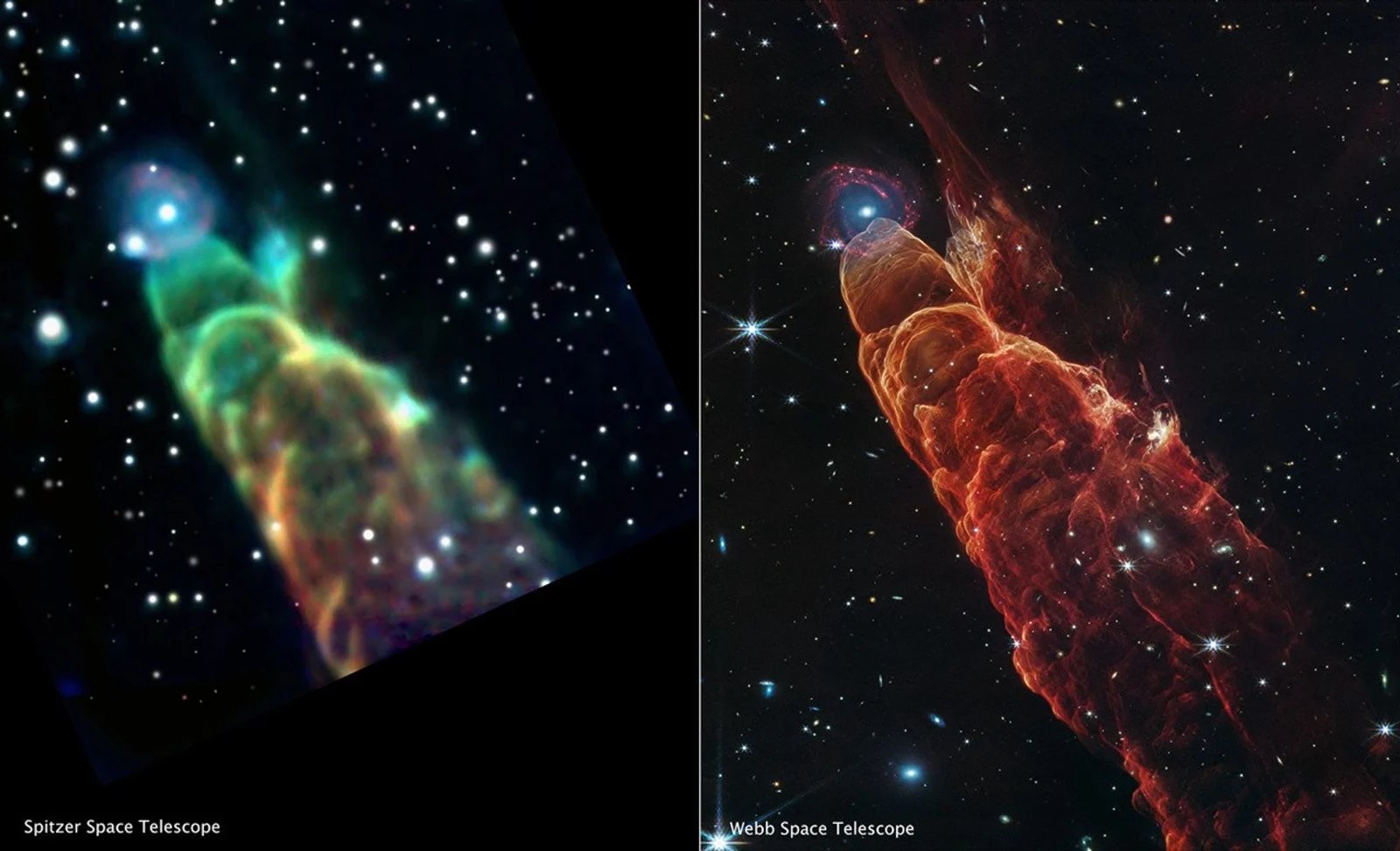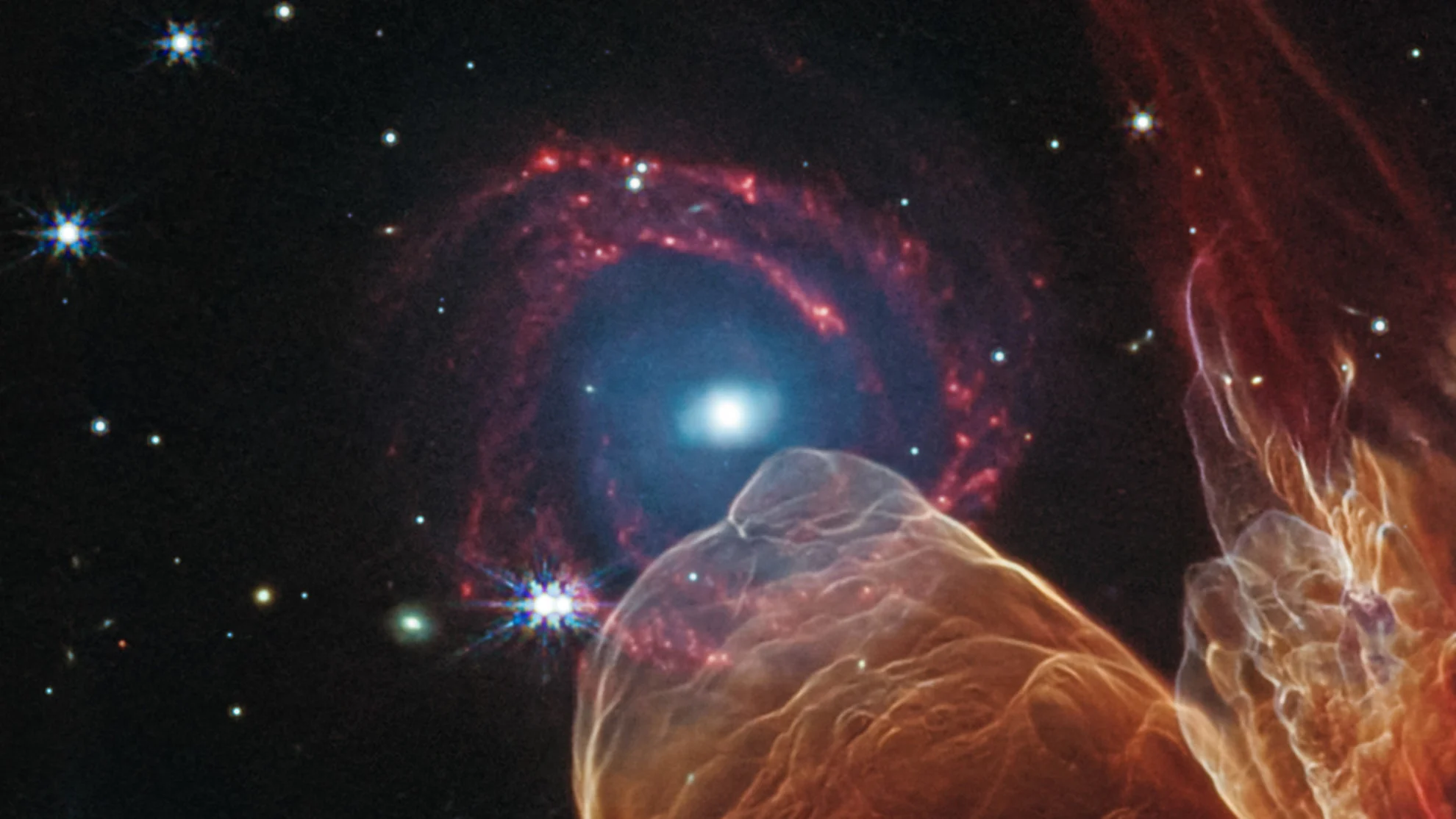
Webb Telescope solves the mystery of the 'Cosmic Tornado'
Fly around the 'cosmic tornado' in a captivating new 3D visualization from JWST.
For nearly 20 years, astronomers have puzzled over the true nature of an object they spied back in 2006. Now, the James Webb Space Telescope has solved this mystery.
On January 12, 2006, astronomers scanning a nearby star-forming region with the Spitzer Space Telescope captured a image of an odd formation, officially named Herbig-Haro 49/50. Herbig-Haro objects are created when newly forming stars (aka protostars) shoot powerful jets of ionized gas out into space. As one of these jets shears through interstellar gas and dust, it energizes that material, causing it to emit light, which can be picked up by our telescopes.
Astronomers have discovered over a thousand Herbig-Haro (HH) objects since the late 19th century. They are named after the two astronomers who first studied them, George Herbig and Guillermo Haro. A famous HH object is the "Sith Star" seen by the Hubble Space Telescope in 2015.
HH-49/50, in particular, is located about 625 light years from Earth, and is found in the southern constellation Chamaeleon. Due to it's unusual shape, astronomers nicknamed it the 'cosmic tornado'.

Herbig-Haro 49/50, aka the 'Cosmic Tornado', as seen by Spitzer in January 2006. The source of the 'tornado', a Class 1 protostar named CED 110 IRS4, is located beyond the right edge of the image. (NASA/JPL-Caltech/J. Bally (University of Colorado))
DON'T MISS: Saturday sunrise solar eclipse set to wow eastern Canada
According to Caltech, "The tornado-like feature is actually a shock front created by a jet of material flowing [across] the field of view. A still-forming star located off the [right] edge of the image generates this outflow. The jet slams into neighboring dust clouds at a speed of more than 100 miles per second, heating the dust to incandescence and causing it to glow with infrared light detectable by Spitzer. The triangular shape results from the wake created by the jet's motion, similar to the wake behind a speeding boat."
The colours of the 'tornado' apparently represent the energy being released by the gas molecules and dust impacted by the outflow. Higher energy near the bow shock results in shorter wavelength blue light, while lower energy, longer wavelength red light is being produced farther back.
Watch below: Hubble pans across the 'Sith Star' Herbig-Haro 24
The mystery that lies in this image is the object in front of the bow shock of the outflow, just left of centre of the field of view.
At the time, astronomers thought it might be a star, surrounded by a faint halo. They also weren't sure if it was associated with the outflow in some way, or just a complete coincidence that it showed up right at the tip of the tornado.
Close to 20 years later, new imagery of Herbig-Haro 49/50 from the James Webb Space Telescope has now solved the mystery!

A side-by-side comparison of HH 49/50 from the Spitzer Space Telescope in 2006 (left) versus Webb in 2025 (right). The Webb image shows off the intricate details of the 'cosmic tornado' far better, but it also resolves the “fuzzy” object located at the tip of the outflow into a distant spiral galaxy. (NASA, ESA, CSA, STScI, NASA-JPL, SSC)
READ MORE: NASA SPHEREx will map the cosmos to unlock its deepest mysteries
Webb and Spitzer are both infrared telescopes, capable of gathering wavelengths of light that are beyond the human eye's ability to see. The difference between the two is that Webb is far more advanced, with a mirror 45 times bigger than Spitzer's for collecting light, and instruments far better at processing that captured light into useful images of the universe. Spitzer was advanced for its time, but Webb is just a reflection of technology getting better over the past two decades.
Webb's much higher resolution view of HH-49/50 has revealed that the mystery object isn't just one star, but billions of them, grouped together in a galaxy located far outside our Milky Way.

A closeup of the unnamed spiral galaxy originally captured in the Spitzer image from 2006, but shown here in much greater detail thanks to the James Webb Space Telescope (NASA, ESA, CSA, STScI)
NIGHT SKY: See a dawn solar eclipse and two meteor showers this Spring
"The galaxy that appears by happenstance at the tip of Herbig-Haro 49/50 is a much more distant spiral galaxy. It has a prominent central bulge represented in blue that shows the location of older stars. It also displays hints of 'side lobes', suggesting that this could be a barred-spiral galaxy. Reddish clumps within the spiral arms show the locations of warm dust and groups of forming stars," the Space Telescope Science Institute said in a recent press release.
As for the alignment, the astronomers that first captured HH-49/50 were correct about that part. It is a complete coincidence of perspective that the tip of the 'cosmic tornado' just happens to end right at this distant spiral galaxy.
"NASA's James Webb Space Telescope captured this beautiful juxtaposition of the nearby protostellar outflow known as Herbig-Haro 49/50 with a perfectly positioned, more distant spiral galaxy. Due to the close proximity of this Herbig-Haro object to the Earth, this new composite infrared image of the outflow from a young star allows researchers to examine details on small spatial scales like never before," says STScI. "With Webb, we can better understand how the jet activity associated with the formation of young stars can affect their surrounding environment."
